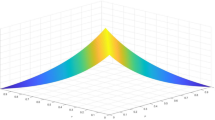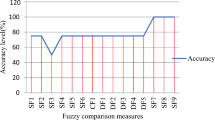Abstract
A fuzzy equivalence relation can be used for clustering. But when using it in applications, we often get a similarity relation rather than an equivalence one because of various reasons. We need to reform it into an equivalence relation close to it to cluster. A commonly used method is transitive closure method, but it usually results in serious distortions about the relation. This paper further studies fuzzy similarity and equivalence relations using fuzzy graphs, and obtains some new results. The defects of transitive closure method are analyzed, and an improved clustering algorithm is given, but it cannot eliminate the inconsistency phenomenon in classification hierarchy structure. To solve this problem, the optimal fuzzy equivalence relation of similarity relation is studied. An optimization model which can derive it exactly is given, but it is too complex for applications. An effective approximation algorithm to get the optimal equivalence relation is thus presented. Several examples and some discussions are also given to illustrate the given methods.
Similar content being viewed by others
Data availability
Enquiries about data availability should be directed to the authors.
References
Arkajyoti S, Swagatam D (2017) Axiomatic generalization of the membership degree weighting function for fuzzy C means clustering: theoretical development and convergence analysis. Inf Sci 408:129–145
Bezdek JC (1981) Pattern recognition with fuzzy objective function algorithms. Plenum Press, New York
Binu M, Mathew S, Mordeson JN (2019) Connectivity index of a fuzzy graph and its application to human trafficking. Fuzzy Sets Syst 360:117–136
Chaira T (2011) A novel intuitionistic fuzzy c-means clustering algorithm and its application to medical images. Appl Soft Comput 11:1711–1717
Fu GY (1998) Optimization methods for fuzzy clustering. Fuzzy Sets Syst 93:301–309
Geng SY, Qu WL (2019) Discrete mathematics, 2nd edn. Beijing University Press, Beijing (in Chinese)
Ghosh P, Kundu K, Sarkar D (2010) Fuzzy graph representation of a fuzzy concept lattice. Fuzzy Sets Syst 161:1669–1675
Hu BQ (2014) Basis of fuzzy theory, 2nd edn. Wuhan University Press, Wuhan (in Chinese)
Kuo RJ, Lin TC, Zulvia FE et al (2018) A hybrid metaheuristic and kernel intuitionistic fuzzy c-means algorithm for cluster analysis. Appl Soft Comput 67:299–308
Li HX (1989) Fuzzy clustering methods based on perturbation. Fuzzy Sets Syst 33:291–302
Liang GS, Chou TY, Han TC (2005) Cluster analysis based on fuzzy equivalence relation. Euro J Oper Res 166:160–171
Liu Y, Jiang YF, Hou T et al (2021) A new robust fuzzy clustering validity index for imbalanced data sets. Inf Sci 547:579–591
Peng ZZ, Sun YY (2007) Fuzzy mathematics and its applications. Wuhan University Press, Wuhan (in Chinese)
Rosenfeld A (1975) Fuzzy graphs. In: Zadeh LA, Fu KS, Shimura M (eds) Fuzzy Sets and their applications to cognitive and decision processes. Academic Press, New York
Rosyida I, Widodo ICR et al (2020) Fuzzy chromatic number of union of fuzzy graphs: an algorithm, properties and its application. Fuzzy Sets Syst 384:115–131
Sameena K, Sunitha MS (2006) Strong arcs and maximum spanning trees in fuzzy graphs. Int J Math Sci 5:17–20
Tan Q, He Q, Zhao WZ et al (2011) An improved FCMBP fuzzy clustering method based on evolutionary programming. Comput Math Appl 61:1129–1144
Wang YJ (2010) A clustering method based on fuzzy equivalence relation for customer relationship management. Expert Syst Appl 37:6421–6428
Yang MS (1993) A survey of fuzzy clustering. Math Comput Model 18:1–16
Zadeh LA (1971) Similarity relations and fuzzy orderings. Inf Sci 3:177–200
Zheng M, Li T, Zheng XY et al (2021) UFFDFR: Undersampling framework with denoising, fuzzy c-means clustering, and representative sample selection for imbalanced data classification. Inf Sci 576:658–680
Acknowledgements
The author would like to acknowledge the financial support from National Natural Science Foundation of China (Grant No. 12171445)
Funding
The authors have not disclosed any funding.
Author information
Authors and Affiliations
Corresponding author
Ethics declarations
Conflict of interest
The author declares that he has no conflicts of interest.
Ethical approval
This article does not contain any studies with human participants or animals performed by any of the authors.
Additional information
Publisher's Note
Springer Nature remains neutral with regard to jurisdictional claims in published maps and institutional affiliations.
Rights and permissions
Springer Nature or its licensor (e.g. a society or other partner) holds exclusive rights to this article under a publishing agreement with the author(s) or other rightsholder(s); author self-archiving of the accepted manuscript version of this article is solely governed by the terms of such publishing agreement and applicable law.
About this article
Cite this article
Chai, Z. A study of clustering on optimal fuzzy equivalence relations. Soft Comput 27, 1415–1424 (2023). https://doi.org/10.1007/s00500-022-07654-z
Accepted:
Published:
Issue Date:
DOI: https://doi.org/10.1007/s00500-022-07654-z




